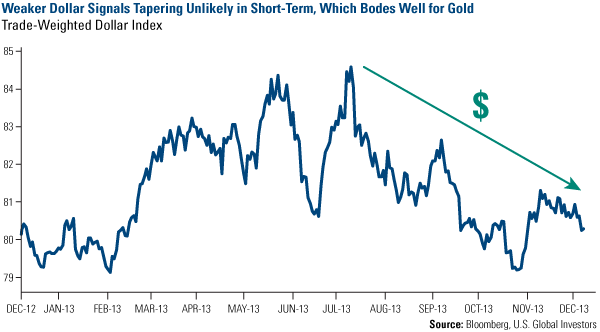Gold Market Radar (December 9, 2013)
For the week, spot gold closed at $1,229.05, down $24.44 per ounce, or 1.95 percent. Gold stocks, as measured by the NYSE Arca Gold Miners Index, declined 7.01 percent. The U.S. Trade-Weighted Dollar Index lost 0.45 percent for the week.
Strengths
- The Chinese yuan overtook the euro to become the second-most used currency in global trade finance in 2013. China is publicly seeking a greater role for its currency in global trade and investment as the state relaxes controls on the exchange rate, fund flows, and borrowing costs. The increase in volume traded was partly a result of agreements announced this quarter to start direct currency trading between the yuan and both the British pound and Singapore dollar. The announcement bodes well for gold in the long term as the People’s Bank of China is likely to continue strengthening its foreign reserves with gold, which will give a stronger backing to the Asian nation’s currency and increase its relevance in global trade finance.
- A report in a major Canadian newspaper highlighted new technological developments taking place in the gold sector which are expected to enhance operational efficiency. Rick Howes, CEO of Dundee Precious Metals, received a call on his personal iPhone while in a deep underground tunnel at the company’s Bulgarian gold mine. The installation of a data network puts Dundee at the forefront of the industry’s next phase, treating mines as just-in-time manufacturing sites, according to the news. CEOs of some of the largest mining companies in the world have made presence on site to learn whether their companies can adopt the data and communications technologies for their own operations.
- Pretium Resources released a total of 95 intercepts from 46 holes drilled into the Valley of the Kings (VOK) zone. The intercepts returned a weighted average grade of 24.8 grams per tonne gold. Management noted the underground drilling has expanded the high-grade mineralization of the VOK to the east, and mineralization remains open in all directions. Reservoir Minerals released assay results for five diamond drill holes at the Cukaru Peki target on the Timok joint venture with Freeport-McMoRan in Serbia. According to Scotiabank analysts, the new infill holes have increased the size of the resource by 22 percent more than their initial estimates.
Weaknesses
- Gold broke through support levels at $1,235 and at $1,225 earlier in the week to make new intraday lows before closing the week at $1,229. During the week, in aftermarket hours, gold made a low of $1,218 before Asian physical buyers stopped the fall. Despite Shanghai physical premiums having picked up, the size of the short positions has increased, and there is a “distinct lack of more broad based appeal for gold at the moment,” according to Scotiabank. UBS lowered its 2014 average gold price from $1,325 to $1,200, adding that it expects weaker prices as the market fluctuates in the crosscurrents of an improving macro backdrop.
- Gold sales from Australia’s Perth Mint, the main bullion refiner in the world’s second-biggest producer, decreased last month as prices declined for a third month. Sales of coins and minted bars fell 32 percent to 52,700 ounces in November from 77,255 in October. Similarly, silver sales were 807,246 ounces in November from 821,580 ounces in October. The U.S. Mint saw a slight decline in the sale of American Eagle coins in November, equaling 48,000 ounces, compared to the 48,500 ounces sold in October.
- Colossus Minerals announced its efforts to secure additional financing have been unsuccessful, and the board of directors has taken a decision that the company's strategy should be reviewed. To achieve that purpose, the company will cease underground development for the time being and focus on de-risking the project. According to Joseph Fazzini of Dundee Capital Markets, it is evident that the decision to de-risk the project comes too late for any significant benefit to be realized in the short term. With the funding shortfall, a change in strategic direction and no imminent path to production, we believe the risk of holding Colossus exceeds the potential rewards.
Opportunities
- A Bloomberg article stated that John Thornton, who is set to become Barrick Gold’s Chairman at the next annual general meeting, is trying to establish partnerships with Chinese companies that may include investment in Barrick and future mining projects as part of his review of the largest gold producer’s long-term strategy. According to Thornton, Barrick is set to benefit by forming relationships with Chinese companies that can provide capital, engineering expertise and political influence.
- One too many of the investors and analysts we speak to on a daily basis is completely oblivious to the recent behavior of the U.S. dollar. The recent macroeconomic data released has helped propel the equity markets higher, based on the notions that (1) the recovery is in full swing and (2) the labor, manufacturing, and economic releases are at multi-year highs. One would expect that the taper talk 2.0 which has followed recent macroeconomic data releases would have the U.S. dollar flying high. But as the chart above shows, the exact opposite has happened. In fact, despite the calls for December tapering piling up on the basis of visible improvements to the labor market, the U.S. dollar has failed to respond. The U.S. dollar trades in the foreign exchange market, which transacts well over $4 trillion on average per day, making it the most liquid market, and clearly one where any type of manipulation is nearly impossible. The interpretation we give to this is that the U.S. dollar weakness signals tapering is unlikely in the short term, and a continuation of the U.S. dollar downtrend is likely. These developments should bode well for gold going into the new year as we expect the historic negative correlation between gold and the U.S. dollar to gain momentum.
- On Monday, David Rosenberg had a short, yet very interesting analysis of up-and-coming inflation in 2014. In his daily write-up for Gluskin Sheff, Rosenberg opines that labor will be the recipient of the income spoils in 2014, which will bring labor inflation up, by “hook or by crook.” He adds that a depleted pool of available labor, evidenced by the low labor participation rate, and new multi-year highs on most measures of labor demand will result in accelerating wage pressure. In addition, minimum wages are poised to rise across the U.S., but this time with more force following the momentum brought by the hiking of minimum wage rates to $15 dollars in a Washington state county.
Threats
- Barclays estimates mining companies will hedge a net 10 tons of gold in 2014, after having bought back 30 tons this year. Despite Barclays’ belief that “large-scale hedging is likely to be limited, given the time and money invested in unwinding positions and in light of continued shareholder preference for exposure to the underlying price,” some executives at the major gold producers insist on the benefits of hedging. Barrick Gold’s Chairman-elect Thornton told reporters this week, “I always thought it made great sense to hedge,” while Charles Carter, an executive vice president at AngloGold Ashanti, said the industry will “slowly return” to forward sales. It is curious both Barrick and AngloGold are optimistic on hedging since the two companies have been some of the greatest offenders when it came to hedging in the past, with Barrick having borrowed heavily, to pay at least $5.6 billion in 2009 to get out of hedging contracts.
- BMO mining analysts are predicting gold stocks are likely to come under heavy year-end tax-loss selling. Two circumstances will make the tax-loss selling particularly damaging this year: not only have gold stocks underperformed dramatically over the course of the year, but the broader equity markets also have been abnormally strong, increasing the incentive for taking advantage of tax-loss selling into the new year.
- According to Mark Bristow, CEO of Randgold Resources, the fact that share prices of many of the world’s top gold companies are at or below the levels at which they traded in 2002, is a sad indictment of an industry that has lived from quarter to quarter, rather than planning for the future. Bristow added that the gold sector can deliver value, yet most of the players in the gold industry have “failed to take advantage of the biggest bull market we have ever experienced.” Bristow concluded by stating that “the industry has been unable to replace even half of the gold it has mined in the past decade,” which doesn’t paint a pretty picture for the industry going forward.
















